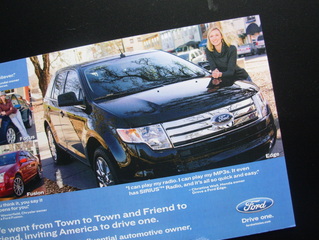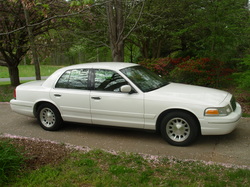
I’ve become a big fan of Ford’s new marketing guru, Jim Farley. He’s got the spark, and Ford needs a lot of spark these days. Ford people, Ford dealers, and the whole US of A should benefit from his commitment and experience.
A recent New York Times article stated that more people like Ford than buy Fords. That dichotomy seemed strange at first, but on second thought, it doesn’t seem so unusual in a time when what people say and what people do don’t always match. This appears especially true in marketing, where it often appears that mostly any glib words will do when creating a tagline, whether they relate to product “truth” or not.
Back in the 1980s, Ford’s Quality Is Job One tagline got America’s attention. People bought into it because the tagline was true – as evidenced in the stylistically daring new Taurus, a car that shouted “Tomorrow!” but also had a solid, practical place in the current day. Even though some of its detractors thought the car’s smooth lines made it look like a jellybean.
If Farley’s Fordmidable new challenge can be described in a few words, it’s to shine up the Blue Oval and create believers in today’s Ford quality, which is much better than the company’s medium-term reputation allows.
I’ve never met Mr. Farley and was barely aware of him before he made the switch from group VP of Toyota’s lauded Lexus division to the helm of Ford a year ago. I’ve never even driven a Lexus. But I have owned quite a few Fords. And the Ford I have now has been one of the best.
My first Ford was a Country Squire station wagon, the one with the fake wood on the side. I was nineteen and drove it on a sales delivery route, my first real job. The car was seven years old, cost $350, and was one of the most memorable Fords ever made -- big round red taillights, a metal dash and an AM radio that sounded great and could get stations from all around the country. My dad sold it when I went in the Army. Sad.
In short order, I bought a used red ’63 Galaxie 500 convertible with a white top, a new 1966 Fairlane two-door hardtop with a stick shift on the column, and finally a canary yellow ’68 Galaxie dealer demo – another convertible -- for what at the time seemed like a lot of cash to spend on a new car: $2850. I coveted a Mustang but didn’t bite for it. Nor did I buy another Ford for many years, thanks to a long professional relationship with a GM dealer – although on business trips during that stretch of time, I often rented a Taurus.
Then, as 2003 turned into 2004, we added a 1998 Crown Victoria to our stable of family cars. By that time, the new car bug had largely been beat out of me in favor of buying older, higher mileage models with plenty of life left in them. I wasn’t in the market for a car as big as a Crown Vic, but let’s just say that the price was right. It had 171,000 miles, looked practically new, and I liked it right away.
It was smooth (good). And big (not so good, except when it came to cramming suitcases in the trunk). Gas was just hitting two bucks when I acquired the Crown Vic, which seemed like unfortunate timing. But the surprise was that this comfortable, roomy car with the turning radius of the Queen Mary got GREAT gas mileage! Typical on the road: 30 mpg – occasionally as much as 33 if I feather-footed. Around town, 22-24. And overall, 25-26. People in their Corollas and Civics could snicker all they want at the dude in the huge Ford they just passed. I may be getting better mileage than they are.
Fact is, the lowbrow reputation American cars have been hung with since the ‘70s hasn’t caught up with the truth of cars like the Crown Vic and its sister model, the Mercury Grand Marquis. Yeah, cabbies and cops drive ‘em (sometimes they wave at me). Grannies and Gramps drive ‘em – in the slow lane. They’re about as desirable to today’s aspirational buyers as a fat, over-chromed ’58 Buick was to me in 1961. But snicker all you want. I can stuff a generous number of passengers and all their bags in my Crown Vic and head on down the road at 65-70 with the AC running and rack up compact-car mileage. The old boat just hit 250,000 miles* and, despite a few more dings, it still runs great and looks almost exactly like all the new police cars. *(as of 10/13 my Crown Vic has 315,498 miles, is going strong and Crown Vics for police work are becoming passe)

If I were Mr. Farley, I’d not forget, while concentrating on the excitement of what’s coming out of the pipeline next, that a lot of people out there – including well-heeled Baby Boomers like him – recall their first Fords with affection, even though they may be driving something else, and yet may be enticed back to a brand that’s equivalent in excitement to the original Mustangs, T-Birds, and even the ’55 - ’57 Sunliners (not to mention the original Crown Victoria, which was a 2-door hardtop with a stainless steel arch that stretched over the top of the car like a chrome crown – my bud’s brother owned one, and we used to sneak joyrides at night, radio blasting, windows down, feeling like heroes).
There also are legions of people out there who bought Tauruses and were well satisfied with their experience before some committee of corporate dimwits assigned the brand to oblivion. They’re now driving Accords, Camrys and Hyundais and could be enticed back into the Ford fold with great cars. And then there are folks like me who like their present Fords -- even though their ride is far from the latest wrinkle in automotive style and performance.
If their stories were well told, many more of these former Ford owners might pony up to the plate for an Edge, an MKZ, or even a Five Hundred/Taurus, which a retired Ford engineer told me a couple of years ago was technologically a great car cleverly disguised with bland styling that said, “I’m Boring. Don’t bother to check me out.”
Yes, there are people who wouldn’t be caught cold stone dead sitting a Ford, much less driving one. I believe, however, that, with the right combination of product and appeal -- and a reminder that the car that once inspired their dreams is still there, somewhere in the corporate DNA, people’s minds can be opened just enough to give the Blue Oval a try.
That’s why I like Farley’s new Drive One campaign. But Drive One is just an ad theme, and no matter how successful it may be in the short run, this is not the magnetic tagline Ford Motor Company needs for the long run. Somewhere out there is that distinctive, strategic turn of phrase that will cause Ford’s next new customers to look at the brand with fresh eyes, no more than a half-dozen well-crafted words that capture both the truth and excitement of today’s Ford products … without leaving the memories behind.
It’ll be fun seeing what Jim Farley comes up with.
TAKE AWAY: Latch onto tomorrow with all you’ve got – but don’t lose sight of what made your brand (or company) great.

 RSS Feed
RSS Feed